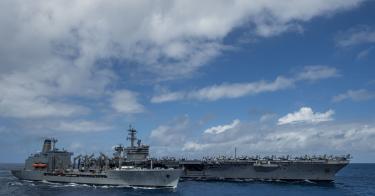Once again, we find ourselves in an era of great-power competition. And the pressures driving current competition among the United States, China and Russia are only intensifying.
In China, growing demographic and economic pressures will come to a head by 2029. Ultimately, failure to deliver on sustained economic growth and cowing of Taiwan will challenge the legitimacy and continuation of the Chinese Communist Party. Complicating things, in the last year, the “One-Country, Two-Systems” construct for a peaceful resolution of China’s unresolved civil war with Taiwan has largely collapsed.
While all that is going on, Russia remains an unrelenting strategic agitator, always seeking to weaken alliances and nations it views as hindering the advancement of its national interests.
It all bodes a rocky road and heavy seas ahead.
As for the seas, analysts at The Heritage Foundation have concluded that several of the gospels and assumptions that have informed U.S. maritime thinking over the last 30 years are simply not suited to contend with this environment. In a new paper, part of our ongoing “Rebuilding America’s Military Project,” we propose a novel approach—Naval Statecraft—which would leverage economic statecraft to execute a global maritime strategy.
>>> Rebuilding America’s Military: The United States Navy
If backed by an appropriately sized, trained and equipped fleet, this approach could successfully contest China’s and Russia’s comprehensive competition and hybrid use of military force. At the same time, it would foster new partnerships that better position the Navy for prolonged competition and success in combat, should war become inevitable.
There is a problem, of course, with strategies that involve long-term horizons. Too often, they generate bureaucratic admiration and lip service but little of the action needed. To overcome this, the report includes “sailing directions,” specific actions needed to drive implementation of the strategy. These actions include: establishing standing task forces in the South China Sea and Eastern Mediterranean, deploying ships with non-lethal capabilities for gray-zone operations, and naming an interagency lead for national maritime efforts.
A new, useful Navy force structure assessment was announced at the twilight of the last administration. That work informs the threat-based analysis that undergirds the Naval Statecraft strategy. We determined that to balance effective peacetime competition with China and Russia and keep pace with the myriad threats for conflict required a Navy fleet of 575 ships operating in decisive theaters taking on new missions requiring several new classes of ships. While well within historical trends, the cost to do this will require increased and sustained topline Navy budgets by as much as $12.3 billion a year through 2035.
It will also require an invigorated partnership between the Navy, Defense Department, industry, and Congress to convince the public that a stronger fleet is needed and achievable.
>>> Russia, China and More: How America Can Address Its Biggest Coming Threats
Moreover, to gain the trust, confidence, and money required to deploy this burgeoning fleet, the Navy must become a smarter shipbuilding customer. One way it can do this is to restore its in-house ship design capacities. In-house engineering expertise and experience will be invaluable in guiding cost-effective shipbuilding into the future.
Since the end of the Cold War, assumptions based on U.S. preeminent military and economic power have encouraged generally passive or reactive national security policies. If the U.S. is to continue to play a leadership role in the world with the requisite influence that ensures its prolonged prosperity, this must change.
Shifting to a proactive strategy centered on the maritime will not be easy. It has been almost 30 years since the U.S. had to contend with the Soviet Union, our sole great-power competitor in the Cold War.
The return of great-power competition requires that the Navy be able to field a war-winning fleet and compete aggressively in the peace. This new research provides one pathway to achieve this.
This piece originally appeared in RealClear Defense




